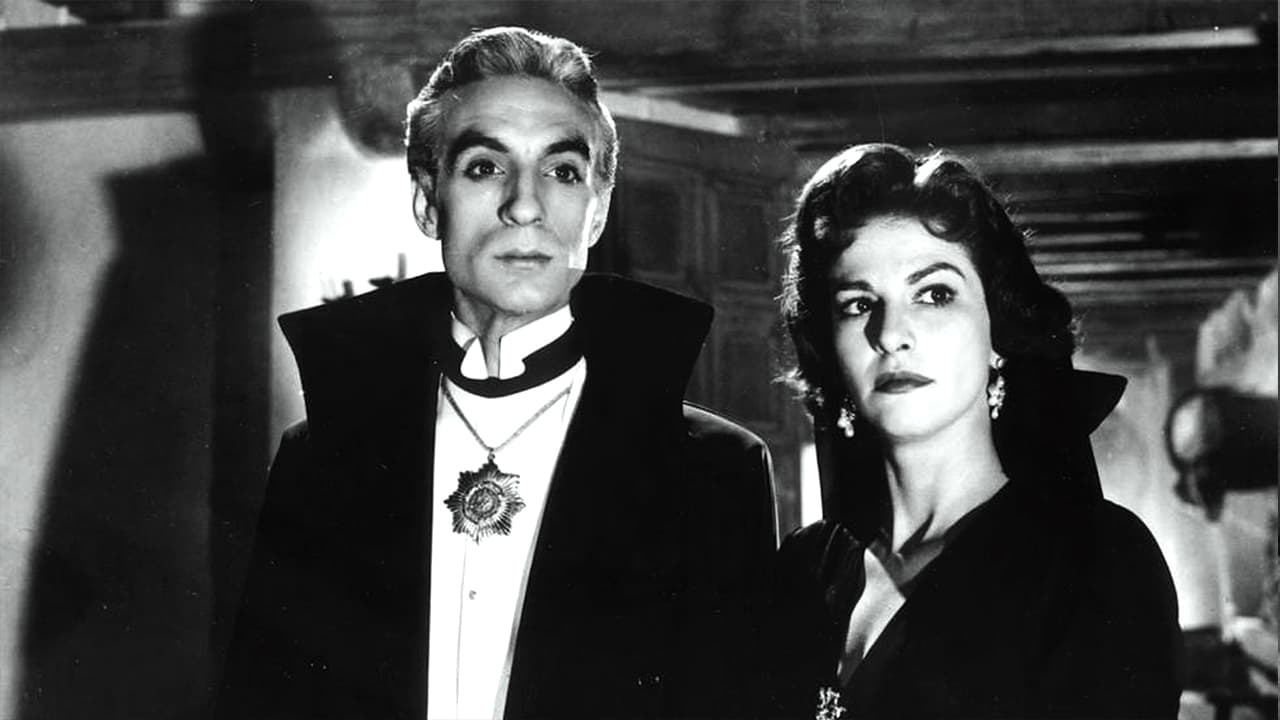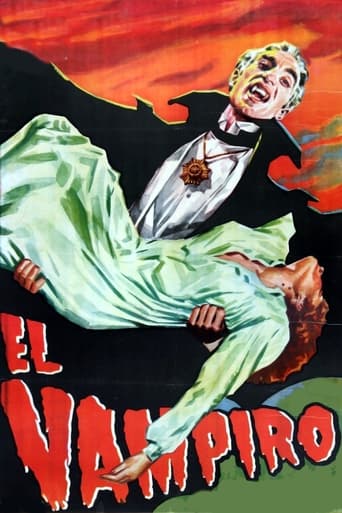MartinHafer
The Mexican horror film, "The Vampire" was followed by "The Vampire's Coffin". Of the two, "The Vampire" is a significantly better film and is still pretty watchable today--even if both films feature the crappiest looking wire effects in the history of vampire films!A woman's aunt has died and she's traveled for the funeral. However, what she doesn't know is that she's walking into a trap by the vampire, Count Lavud (also known as Duval). It's up to her new male friend to help her--as well as very unlikely help from beyond the grave!While I'd never call this film especially good, it's quite atmospheric and worth seeing if you like the genre. But, you have to ignore all the obvious wires supporting the bats as well as the wire on the sword that Lavud tries to use on our hero near the end. And, like the sequel, this vampire is no Dracula. Drac was incredibly strong and rather smart-- this one is neither, though he does have style. And, he tells everyone he comes from the land of Baconia....ummm...bacon!!
ferbs54
The DVD company known as Casa Negra has managed to impress me yet again. Specializing in Mexican horror films of the classic era of 1956-'65, this outfit had previously wowed me with great-looking, extras-packed DVDs of such wonderful films as "The Brainiac," "The Witch's Mirror," "The Man and the Monster," and especially "The Black Pit of Dr. M" and "The Curse of the Crying Woman" (I personally deem that last one a horror masterpiece). And now, "The Vampire," which was originally released in 1957 under the title "El Vampiro"...and a good thing, I suppose, as there seems to have been a little-seen American film called "The Vampire" released that same year. "El Vampiro" was directed by Fernando Mendez, who had previously made a mark on Mexican audiences with his 1956 horror picture "Body Thief," so much so that producer Abel Salazar hired him to helm his film the following year. As the story goes, Salazar was trying to figure out why Universal Studios in America was so profitable, and the answer suddenly dawned on him: monster movies! And so, "El Vampiro" was born, a film that has since been described as "Dracula on a hacienda"!In the film, pretty Marta Gonzalez (Ariadna Welter) experiences a tough homecoming to her childhood abode, Sicomoros. Her Aunt Maria has just died and been entombed, while talk of a pillaging local vampire sweeps through the nearby town of Sierra Negra. To make matters worse, Marta soon realizes that her Aunt Eloisa (Cuban actress Carmen Montejo) does not do so well at reflecting in a mirror herself, and their neighbor, the caped Count Duval (Spanish émigré German Robles), is making pestiferous offers to purchase Sicomoros for his own mysterious ends. Fortunately for Marta, a kindly stranger, Dr. Enrique (Salazar, who would go on to star in "The Brainiac" and "...Crying Woman"), has accompanied her from the train station, as Marta will need all the help she can get after she realizes that Duval is in actuality...the dreaded nocturnal neck nosher himself....True to its Universal inspiration, "El Vampiro" presents us with vampires very much in the traditional, uh, vein. Thus, they are able to turn into bats, do not reflect in mirrors, are able to pop in and out of any location, can hypnotize from afar, communicate with each other telepathically, suffer from what I suppose you might call crucifixaphobia, sport long canine teeth, can be killed by a stake through the heart, sleep all day in their dirt-filled coffins...and must suck the blood from the living, natch, claiming victims as their own after two bites. The film, though never especially frightening, yet manages to offer at least three quite startling scenes. In one, Duval becomes a bat and flies straight at the throat of a screaming little boy; in another, Marta opens the door to her long-disused childhood bedroom and sees what appears to be the ghost of her dead Aunt Maria; and finally, in the film's exciting conclusion, Enrique and Duval face off, while the unconscious Marta is threatened by a blazing inferno. And if the special FX in the film are a bit weak as compared to Universal's monster pictures (especially the vampire-to-bat transformations), they are still endearingly so. Perhaps the two best elements of the film, aside from some solid acting by all and a no-nonsense story line, are the remarkable sets by Gunther Gerszo and the stunning B&W photography of Rosalio Solano. This film looks fantastic! Other than Italian director Mario Bava, I can think of no other filmmakers who have given us such convincingly decrepit and molderingly morbid crypts and sets as the Mexicans of this classic period. Filmed utilizing deep-focus long shots, the sets here of interior courtyards, tombs and woods are things of genuine beauty. And just get a load of the mists that seem to be perpetually hanging in the air; not swirling mists, as might be expected, but layers of stationary streamers that just seem to hover motionlessly in the atmosphere. These mists are easily the film's single best effect. I cannot figure out HOW the filmmakers managed to bring these amazing images off, but these mists, added to those remarkable sets, go a long way in engendering a nicely creepy miasma; a most suitable backdrop for our two impressive-looking undead.I have read that Abel Salazar has been criticized for being a "weak hero" in this film, and truth to tell, his character DOES indeed seem scared when dueling with the vampire near the conclusion (Enrique uses a torch; Duval, a sword!). But you know what? His understandable fright only makes him come off as more realistic, more appealing. I have always enjoyed Salazar's ingratiating screen presence, and find him to be perfectly acceptable here. In "El Vampiro"'s sequel, 1958's "The Vampire's Coffin" (a sequel that started shooting even before the original film was released!), Salazar returns as Dr. Enrique, and in that latter film, he might easily be accused of making some questionable moves. But not here. The bottom line is that "El Vampiro," if not as solid an effort as "Black Pit..." or "...Crying Woman," remains a very fine horror picture that should manage to impress genre fans almost six decades after its release. And need I even mention all the wonderful extras on this Casa Negra DVD? The photo essay on Mexican horror films alone is worth the price of admission....
Coventry
Fernando Méndez' "El Vampiro" is atmospheric and competently made 50's Mexican horror, but it isn't nearly as mesmerizing as some of the contemporary genre-achievements coming from that same country, like "The Black Pit of Dr. M" (also directed by Méndez) and "Curse of the Crying Woman". This is mainly because the premise of the film hasn't got anything truly original to offer. Like the title implies already, it's a standard vampire tale with a plot revolving on a Hungarian count surviving on the blood of local Mexican women and hoping to resurrect his long lost brother from the dead. To achieve this, Count de Lavud needs to get inside the family vault of the Gonzalez' hacienda. He already seduced aunt Eloisa and made her one of his immortal brides, and when the beautiful niece Martha returns to the family mansion after several years, the count plans to take over her will as well. Martha's only hope for rescue lies with her mysterious traveling partner, a doctor of some sort, and her devoted uncle Emilio. The Gothic decors and the incredibly stylish black & white photography are a true lust for the eye, but the film is too talkative and lacking moments of genuine suspense. Multiple other reviewers around here seem convinced that this movie, and lead actor Germán Robles' performance in particular, severely influenced Hammer Studios before they came up with their interpretation of Dracula. Perhaps this is true, judging by the extended close-ups of Robles' penetrating stare, but still Christopher Lee portrays a much more petrifying and memorable monster. The entire middle section of the film drags a little and Méndez spends too much time on the relationship between Martha and Dr. Enrique. There are, however, hints at one really inventive sub plot in the script, involving a prematurely buried other aunt, but that particular storyline isn't properly elaborated like it should have. It's a shame about the story, but "El Vampiro" is nevertheless recommended viewing if it were for the sinister atmosphere and ominous set pieces alone.

